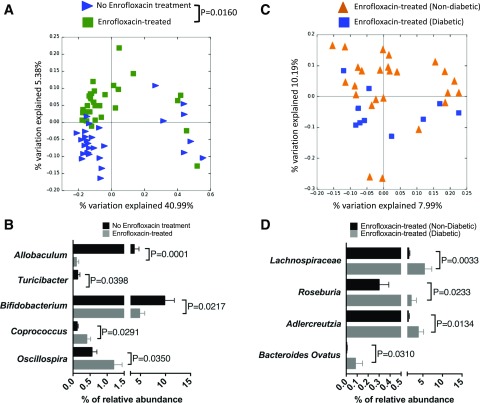Figure 4.
Altered microbial composition in A22Cα−/−PI2−/− NOD mice by enrofloxacin treatment and diabetes development. A: PCoA plot of β-diversity from fecal bacteria of 6-week-old A22Cα−/−PI2−/− NOD mice that were untreated (n = 29) or treated with enrofloxacin (n = 35). B: Altered microbiota composition expressed as a percentage of relative abundance of the bacterial genus. All bacteria belong to the Firmicutes phylum except Bifidobacterium, which belongs to the Actinobacteria phylum. C: PCoA plot of β-diversity from fecal bacteria of 6-week-old A22Cα−/−PI2−/− NOD mice treated with enrofloxacin that were nondiabetic (n = 25) or diabetic (n = 10) by the end of the observation period (10 weeks old). D: Altered microbiota composition expressed as a percentage of relative abundance from the genus level except Bacteroides ovatus (species level) and Lachnospiraceae (family level). Lachnospiraceae and Roseburia (a member of Lachnospiraceae) are both members of the Firmicutes phylum; Bacteroides ovatus belongs within the Bacteroidetes phylum, whereas Adlercreutzia belongs within the Actinobacteria phylum. Analysis of similarities was used to analyze β-diversity of taxonomic families of gut microbiota in A and C. B and D were assessed for statistical significance using a Student t test.

